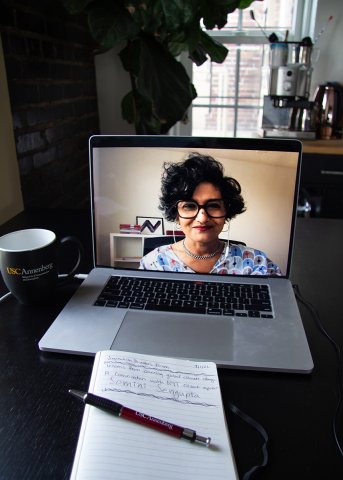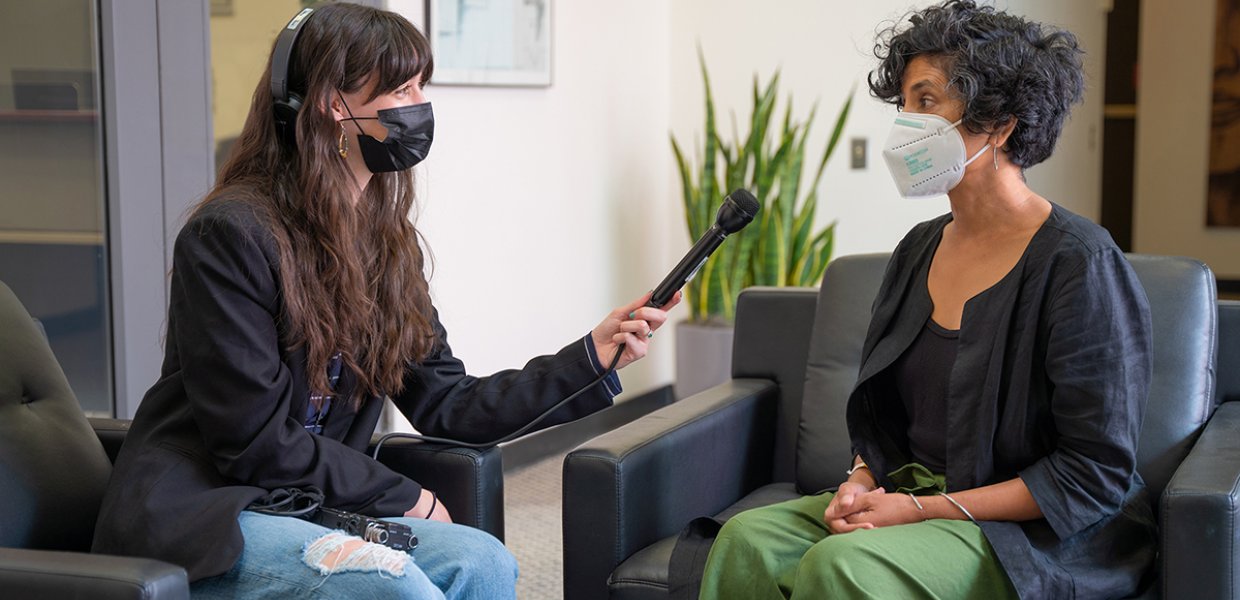“If the hypothesis is — we are doomed — there is really no scientific evidence to support that hypothesis.” This is one of the first things New York Times international climate reporter Somini Sengupta told the audience during a Feb. 1 Journalism Director’s Forum. “We have choices and the choices we make during this decade to draw down emissions of planet warming gases are crucial … to stave off the worst impacts of climate change.”
Sengupta, this year’s Hearst Foundations Visiting Professional in Journalism, arrived at USC Annenberg on Jan. 30 and spent the week sharing the lessons on climate change she has learned as a journalist working in over 40 countries around the world. The Hearst Foundations program, established in 2001, introduces journalism and public relations students to emerging trends, technologies and career paths in the field of journalism.
During the Feb. 1 event, Sengupta discussed predictions, probabilities and promises made by big corporations about how climate change can and might be handled over the next few years. She also discussed how young people can use the tools they are learning in school to amplify and leverage their influence globally.
“In a school of storytelling, this is where many of you come in,” Sengupta said. “The story of climate change, how we live with it and how we are changed by it, is one of the most transformative stories of our time.”
In addition to the seminar, during her week-long series of conversations, Sengupta was interviewed for Annenberg Media’s “Match Volume” podcast, guest lectured in classes across the university, and met with sustainability and climate change groups.

For Annenberg Media’s Match Volume podcast, MS in journalism student Alexandra Applegate asked: “You said that eventually the majority of journalists will be climate journalists, so what advice would you give young journalists who will likely be covering some form of this crisis?”
SS: I think it’s really important to see climate stories in everyday, ordinary ways. So, wherever you live, try to think about climate stories. Either a climate change problem that is affecting people in one place or [a story about] who’s doing something about it. And finally, the story of climate change is ultimately a story about people. When you are thinking about story ideas, it’s helpful to keep individuals at the center of that. To try and tell it through one person or through a group of people or through a family or community who is dealing with something.
Really try to be comfortable with science, understand how to read a scientific paper, how to ask questions, lots of questions. There is no such thing as a dumb question. And take advantage of your college years to really feel comfortable in understanding science.
*
Representing the student sustainability committee of the Presidential Working Group on Sustainability at the Feb. 1 Journalism Director’s Forum, communication and religious studies major Gabe Romero asked: “What kind of advice do you have for us as students? To not only inspire the student body, but motivate them to act on climate change?”
SS: Humbly, as I'm a journalist, I don’t think it’s appropriate for me to tell you what to do. I invite you to learn more about this, to educate yourself and I’ll tell you what works for me. That’s all I can do. What works for me is to have a sense of purpose. So, in my lane, given what I know how to do, this is my purpose to help you understand the impact of climate change and what is being done to address it. Your purpose is for you to find and to plug in ways that you feel of use and in ways that you can be part of something bigger than yourself. And you’ve already chosen that, right? You’re with your people, so you’re already there.
Another question — “How did you make climate change your beat?” — came from Yusra Farzan, a master’s student in the specialized journalism program.
SS: That’s a really good question. I’ve covered all kinds of beats. I’ve covered a little bit of politics. I’ve covered poverty and I’ve covered 10 wars as an international correspondent. Increasingly, I saw the impact of climate change around the world. As a correspondent, I wrote the occasional story here and there, and it was only in around 2017 when our climate team was expanding and there was a new job as an international climate correspondent, that I raised my hand. It seemed like a way to just learn more and tell really great stories from everywhere.
*
In “Climate Stories,” a course taught by Professors Mike Ananny and Colin Maclay and guest lecturer Noy Thrupkaew, MS in journalism student Tatum Larsen asked: “You said your work is heavily rooted in science, the work I want to do involves history as well. How do you weave history into your pieces?”
SS: One way to think about history is how did we get here? So, the story of climate change is very much a story of colonialism and extractive industries. Locally, you might tell this story if you look into what else was happening in addition to climate change. For example, a story I wrote about Manila and San Francisco — Manila has been sinking, not just because of sea-level rise, but because the land is subsiding due to other activities that have been going on for a long time. Meanwhile in the Bay Area, because of planning decisions that were made, people have been allowed to build houses right at the cliff edge with grand views. So even when you’re writing about a specific place, the decisions that have been made to build there, or to grow food there, or how a city has been racially segregated over the years, impact very much who lives in what kind of neighborhoods and who suffers the consequences of heat waves. So not only is a story of climate change a story of global history — but for every local story — you also have to peel back and ask the question, how did we get here?
Read more about Sengupta’s climate coverage in the Times Climate Fwd newsletter.
